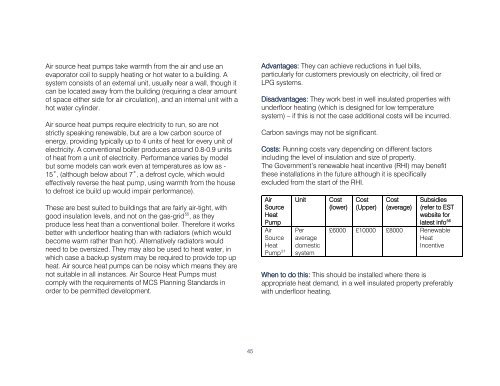Retrofitting Historic Buildings - Westminster City Council
Retrofitting Historic Buildings - Westminster City Council
Retrofitting Historic Buildings - Westminster City Council
You also want an ePaper? Increase the reach of your titles
YUMPU automatically turns print PDFs into web optimized ePapers that Google loves.
Air source heat pumps take warmth from the air and use anevaporator coil to supply heating or hot water to a building. Asystem consists of an external unit, usually near a wall, though itcan be located away from the building (requiring a clear amountof space either side for air circulation), and an internal unit with ahot water cylinder.Air source heat pumps require electricity to run, so are notstrictly speaking renewable, but are a low carbon source ofenergy, providing typically up to 4 units of heat for every unit ofelectricity. A conventional boiler produces around 0.8-0.9 unitsof heat from a unit of electricity. Performance varies by modelbut some models can work even at temperatures as low as -15˚, (although below about 7˚, a defrost cycle, which wouldeffectively reverse the heat pump, using warmth from the houseto defrost ice build up would impair performance).These are best suited to buildings that are fairly air-tight, withgood insulation levels, and not on the gas-grid 55 , as theyproduce less heat than a conventional boiler. Therefore it worksbetter with underfloor heating than with radiators (which wouldbecome warm rather than hot). Alternatively radiators wouldneed to be oversized. They may also be used to heat water, inwhich case a backup system may be required to provide top upheat. Air source heat pumps can be noisy which means they arenot suitable in all instances. Air Source Heat Pumps mustcomply with the requirements of MCS Planning Standards inorder to be permitted development.Advantages: They can achieve reductions in fuel bills,particularly for customers previously on electricity, oil fired orLPG systems.Disadvantages: They work best in well insulated properties withunderfloor heating (which is designed for low temperaturesystem) – if this is not the case additional costs will be incurred.Carbon savings may not be significant.Costs: Running costs vary depending on different factorsincluding the level of insulation and size of property.The Government’s renewable heat incentive (RHI) may benefitthese installations in the future although it is specificallyexcluded from the start of the RHI.AirSourceHeatPumpAirSourceHeatPump 57UnitPeraveragedomesticsystemCost(lower)Cost(Upper)Cost(average)Subsidies(refer to ESTwebsite forlatest info 56£6000 £10000 £8000 RenewableHeatIncentiveWhen to do this: This should be installed where there isappropriate heat demand, in a well insulated property preferablywith underfloor heating.45
















